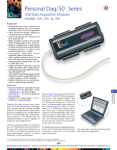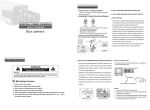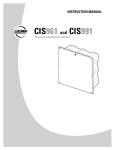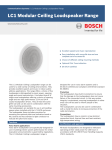Download Sine Systems AFS-3 Specifications
Transcript
Audio Failsafe Model AFS-1 – Instruction Book – This documentation is valid for Audio Failsafe hardware version 2.00 Nashville, Tennessee Table of Contents Section 1 — Warranty/Product Registration Paragraph Title 1.1 1.2 1.3 Warranty Suitability For Use Product Registration Page Number 1.1 1.1 1.1 Section 2 — Safety Information Paragraph Title 2.1 Safety Information Page Number 2.1 Section 3 — Specifications Paragraph Title 3.1 3.2 3.3 General Audio Input Relay Output Page Number 3.1 3.1 3.1 Section 4 — Equipment Description Paragraph Title 4.1 4.2 Functional Description Physical Description Page Number 4.1 4.1 Section 5 — Installation Paragraph Title 5.1 5.2 5.3 5.4 5.5 5.6 5.7 5.8 5.9 Unpacking Mechanical Installation Electrical Installation Power Connection Relay Connection Audio Connections Loss of Power to AFS-1 Safety Considerations Modifying Operating Parameters Version 2.00 Page Number Table of Contents 5.1 5.1 5.1 5.1 5.1 5.2 5.2 5.2 5.3 Section 6 — Circuit Description Paragraph Title 6.1 6.2 Audio Section Power Supply Page Number 6.1 6.1 Section 7 — Illustrations and Diagrams Paragraph Title Page Number 7.1 7.2 7.3 List of Illustrations and Diagrams AFS-1 Schematic Diagram AFS-1 Component Locations 7.1 7.2 7.3 Section 8 — Parts List Paragraph Title 8.1 AFS-1 Audio Failsafe Parts List Version 2.00 Page Number Table of Contents 8.1 Section 1 — Warranty/Product Registration 1.1 Warranty Sine Systems, Inc. agrees to repair or replace the AFS-1 Audio Failsafe at no cost, if the unit fails in normal use, during the first year of original ownership. This Warranty does not include damage caused by improper installation or use nor does it include damage caused by any other external means. 1.2 Suitability For Use The purchaser and user of the Sine Systems AFS-1 Audio Failsafe bears the sole responsibility for determining suitability of this equipment for their intended use. Because this equipment can, as can any electronic equipment, fail in an unpredictable or unexpected way, even in normal use, Sine Systems, Inc. cannot be held responsible for damages, either direct or indirect, resulting from use of this equipment. Under no circumstances should this equipment be used or relied upon in a situation where a lifethreatening condition could result if the equipment were to fail. 1.3 Product Registration To help us know our customers and to keep them informed of future engineering, product, and safety information, please fill out the following form and send a copy to Sine Systems at the address below. It is not necessary to return this form to validate the warranty but it is necessary if you wish to receive engineering bulletins. If you did not purchase the equipment new, we still encourage you to register as an owner so that you will automatically receive all pertinent safety and product information. Record the following information and return a copy to the address shown on the front cover of this book: AFS-1 Serial Number (stamped on front panel) ___________________________________ Name of purchaser (company or call sign): _______________________________________ Mailing address: ____________________________________________________________ Contact Name: ______________________________________________________________ Telephone: _________________________________________________________________ Purchased from: ____________________________________________________________ Date delivered: ______________________________________________________________ Version 2.00 Warranty/Registration page 1.1 Section 2 — Safety Information 2.1 The AFS-1 Audio Failsafe should be installed only by qualified technical personnel. Incorrect or inappropriate installation could result in a hazardous condition. Service of the AFS-1 Audio Failsafe should be performed only by qualified technical personnel. Even though the AFS-1 is powered by 12 volts AC from a "wall plug" transformer, failure of this transformer could cause dangerous and potentially lethal voltages to become present. Only the supplied transformer should be used. Because of exposed terminals, high voltage (greater than 25 volts) should not be connected to the relay terminals, or any other terminals on the AFS-1. If the AFS-1 is connected so that loss of audio turns a transmitter off, the return of audio could turn a transmitter back on. Operating and maintenance personnel should be mindful of this possibility and be sure the transmitter is rendered inoperable before maintenance is begun on the transmitter, antenna, or associated equipment. The AFS-1 is designed for indoor use in a dry location. Installation and operation in other locations could be hazardous. Version 2.00 Safety Information page 2.1 Section 3 — Specifications 3.1 General Output Relay Operation Output relay contact closes within one second after audio becomes present and remains closed as long as audio is present. Output relay contact opens at the end of an adjustable delay period after audio becomes absent. Delay Range 7 seconds to approximately 4.5 minutes. (factory adjusted to approximately 4.5 minutes) Indicators 1. Audio Present (Green LED) 2. Relay Closed (Green LED) 3.2 Audio Input Number Of Audio Inputs Input Type Input Impedance Sensitivity (For Relay Closure) 2 Actively Balanced 60 K Ohms -16 DBv 3.3 Relay Output Output Type Contact Ratings 1 Form "A" (SPST) Contact, Floating 120 Volts AC, 5 Amps Resistive/2 Amps Inductive Version 2.00 Specifications page 3.1 Section 4 — Equipment Description 4.1 Functional Description The AFS-1 is designed to monitor one or two audio signals and provide a relay contact closure as long as at least one of the audio signals is present. When neither audio signal is present for an adjustable delay period (7 seconds to 4.5 minutes), the relay contact opens and remains open until one or both of the audio signals return. The AFS-1 was designed to provide a means to turn a device off (or on) remotely by discontinuance of an audio signal. A typical application of the AFS-1 is to provide an alternate control means for a remotely controlled broadcast transmitter. When appropriately installed, the AFS-1 can be used to turn off a transmitter by discontinuing the audio feed to the transmitter. This procedure would normally be used only when the normal remote control means had failed. 4.2 Physical Description The AFS-1 is contained in a small "modem-sized" case (5.5" x 5.5" x 1.75") and can be mounted in any convenient location such as on a wall, inside an equipment rack, or it may be rack mounted with an optional kit. A 12 volt AC "wall plug" transformer (supplied) is connected to the AFS-1 and provides power. Audio and relay connections are made on "pluggable" screw-terminal connectors on the front panel. LED's are also included to show when audio is present and when the relay contact is closed. A switch is provided to force closure of the relay contacts and defeat operation of the AFS-1. The audio sensitivity and relay timing satisfactory for most applications. Instructions on how to accomplish Parameters" paragraph in Section 5 of Version 2.00 of the AFS-1 are factory set to values which will be These values can easily be changed, however. this are located in the "Modifying Operating this manual. Equipment Description page 4.1 Section 5 — Installation Installation of the AFS-1 Audio Failsafe should be performed only by a qualified technician. Installation is not difficult; however, an attempted installation by a person who is not technically qualified could result in danger to operating or maintenance personnel, or damage to the unit. 5.1 Unpacking When the AFS-1 is unpacked, it should be inspected for obvious signs of mechanical damage or loose parts. Loose parts should be tightened before installation. If damage is found, save the packing material and report it to the shipping company and the dealer from which it was purchased. Do not install the unit. 5.2 Mechanical The AFS-1 generates little heat and can be mounted in just about any convenient location. It can be mounted in the bottom of an equipment rack, it can be wall mounted, or it can be rack mounted with the optional RK-3 rack mount kit. 5.3 Electrical Electrical connections are made to the AFS-1 through two screw-terminal connectors located on the front panel. Note that these can be removed from the panel by pulling them straight out. This makes wiring to these connectors considerably easier. 5.4 Power Connection Power to operate the AFS-1 is supplied by a 12 volt AC "wall plug" transformer supplied with the AFS-1. The leads of this transformer should be stripped and connected to the terminals marked "12 VAC" on the front panel of the AFS-1. If the supplied transformer is of the type that has a connector on the end of the cord, simply cut the connector off and discard it. 5.5 Relay Connection The contacts of the internal relay are accessed by the terminals marked "RELAY." This connection is closed when audio is present and opens after an adjustable period of time without audio (7 seconds to 4.5 minutes). Version 2.00 Installation page 5.1 Although the relay contacts are rated at 120 volts AC, it is not recommended that 120 volts AC be connected to the AFS-1. The screwterminal connectors have several exposed points that could produce a dangerous or even lethal shock if they were contacted. Low voltage AC or DC is much safer and eliminates the potential for a shock hazard. The "G" terminal next to the "RELAY" terminals is a connection to the internal circuit ground but it is not connected to the case. 5.6 Audio Connections Audio connections are made to the AFS-1 through the screw-terminal connector on the left hand side of the front panel. There is an "A" channel input and a "B" channel input. Either one or both channels may be used. If two stereo channels are fed to the inputs, note the polarity of the audio connections or cancellation of the signals will result in the AFS-1. If only one audio source is used, connect it to either input and leave the other input disconnected. The "G" terminal is connected to the internal circuit ground and its use is optional. Generally, the most desirable location to "tap" the audio signal for use by the AFS-1 is a point where the signal level is somewhere between 0 dBm and +10 dBm. This could be the output of a discrete STL, the output of audio processing equipment, or the transmitter's audio input terminals. Note should be made of installations using telephone lines for program audio sources. Since the audio level of incoming telephone lines is generally in the range of -30 dBm, the output of a processing device would be a good monitoring point in such installations. The audio input impedance of the AFS-1 is approximately 60 KΩ so bridging the AFS-1 across a program source usually has no significant effect. After installing the AFS-1 be sure to test that the "AUDIO" LED does in fact go off if audio is lost. Otherwise the timing interval will never begin and the AFS-1 will not work as intended. 5.7 Loss of Power to AFS-1 It should be noted that if power is lost to the AFS-1, the control relay will open. If it is necessary to disconnect power to the AFS-1 without opening the relay contacts, place the switch on the front panel in the "DEFEAT" position before disconnecting power. 5.8 Safety Considerations If the AFS-1 is connected so that loss of audio turns a transmitter off, the return of audio could turn a transmitter back on. Operating and maintenance personnel should be mindful of this possibility and be sure the transmitter is rendered inoperable before maintenance is begun on the transmitter, antenna, or associated equipment. Version 2.00 Installation page 5.2 5.9 Modifying Operating Parameters The AFS-1 operating parameters can easily be modified to suit special applications. The period of time required after the loss of audio before the relay contact opens is set at the factory to approximately 4.5 minutes. This can be adjusted with the 22 turn potentiometer located on the AFS-1 main board. The adjustment range is approximately 7 seconds to 4.5 minutes. Version 2.00 Installation page 5.3 Section 6 — Circuit Description 6.1 Audio Section The first two sections of U1 are balanced audio input stages of the "A" and "B" audio inputs. Overall, these have a gain of 0.33 (loss). The next stage combines the two channels and has a gain of 10. Capacitors C1 through C12 provide high frequency roll-off and RFI immunity. A rectifier, short term integrator (about 1 second), and comparator follow. When audio is present, the "AUDIO" LED is turned on by this comparator. R8 and C14 form the network which determines the timing interval. The following comparator drives the output relay and the "RELAY" LED. 6.2 Power Supply The 12VAC input is rectified and filtered by BR1, VR1, and C15 to produce 18VDC unregulated output. R9 provides a low impedance "mid-point" connection for the various circuit elements. Version 2.00 Circuit Description page 6.1




















